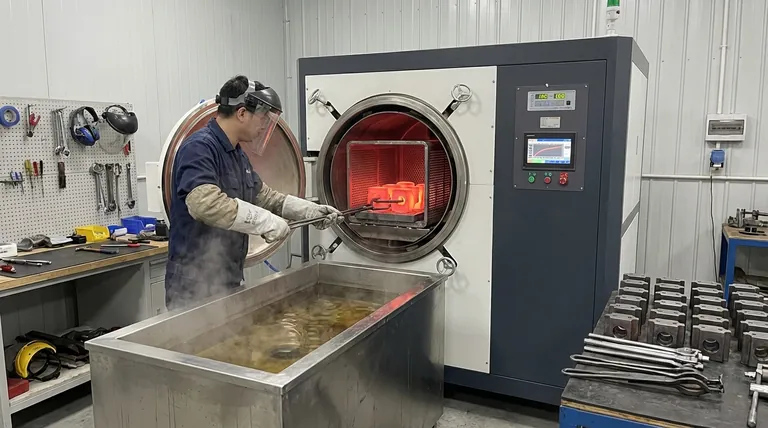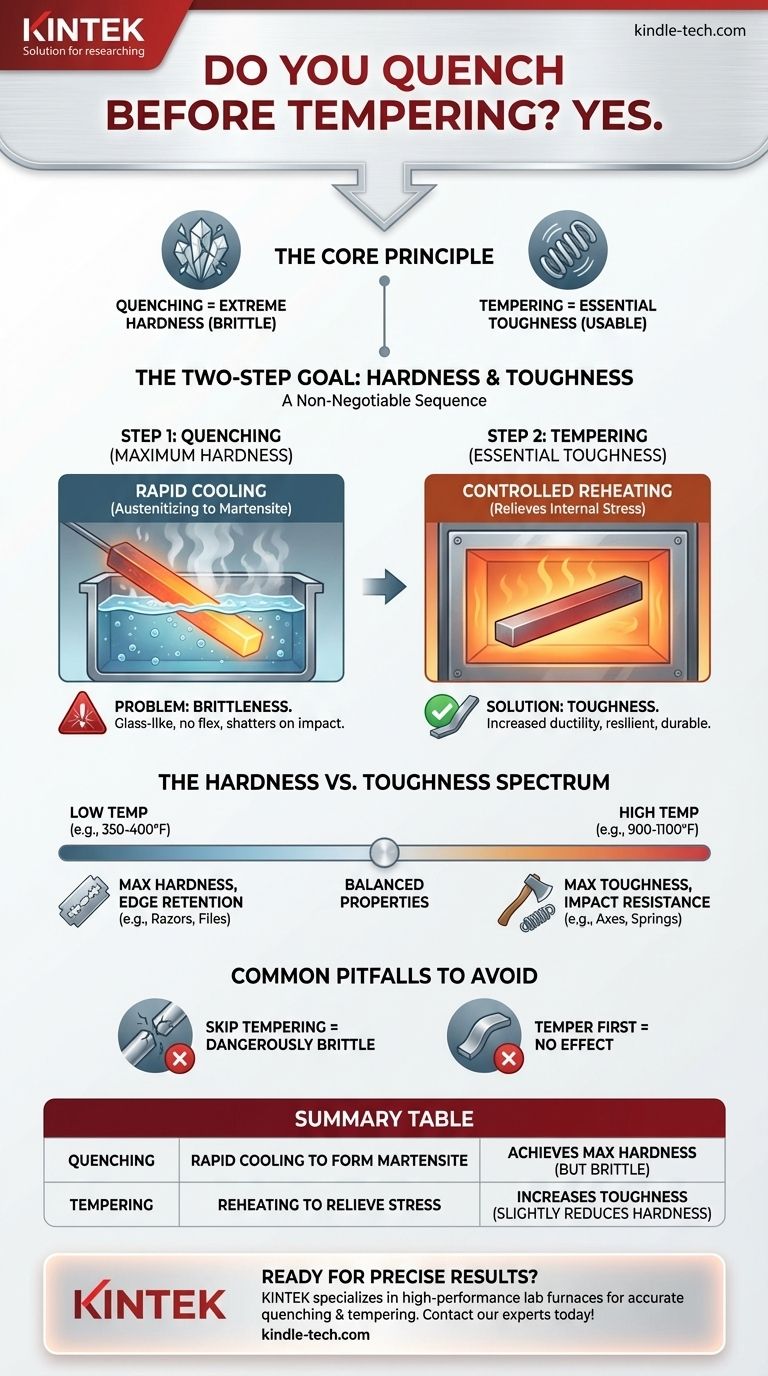Yes, you must always quench steel before you temper it. This sequence is the absolute foundation of the heat-treating process. Quenching is the step that creates extreme hardness, while tempering is the subsequent step that reduces the resulting brittleness to make the steel tough and usable.
The core principle of heat treatment is a two-step process: quenching creates a hard but brittle internal structure (martensite), and tempering refines that structure, trading a small amount of hardness for a massive increase in toughness.

The Two-Step Goal: Hardness and Toughness
The entire purpose of heat treating carbon steel is to manipulate the trade-off between hardness (the ability to resist abrasion and hold an edge) and toughness (the ability to absorb impact and resist fracture). These two properties are achieved through two distinct, sequential steps.
Step 1: Quenching for Maximum Hardness
Before anything else, the steel is heated to a specific critical temperature (a process called austenitizing). At this temperature, the steel's crystal structure changes, allowing carbon to dissolve into the iron matrix.
The quench is the rapid cooling of the steel from this critical temperature in a medium like oil, water, or air. This sudden drop in temperature traps the carbon atoms, forcing the formation of a new, highly strained, and very hard crystal structure called martensite.
Achieving a fully martensitic structure through quenching is how steel reaches its peak potential hardness.
The Problem with Hardness: Brittleness
A fully hardened, un-tempered piece of steel is incredibly brittle. In its martensitic state, it behaves more like glass than metal.
While it can be exceptionally hard, it has almost zero toughness. It cannot bend, flex, or absorb any significant impact without chipping or shattering catastrophically. This makes it useless for nearly all practical applications.
Step 2: Tempering for Essential Toughness
Tempering is the solution to the brittleness problem. It involves reheating the quenched steel to a much lower, precisely controlled temperature (well below the critical temperature used for quenching).
Holding the steel at this tempering temperature allows some of the trapped carbon to precipitate and the distorted crystal lattice to relax. This process relieves the massive internal stresses created by the quench.
The result is a significant increase in toughness and ductility, making the steel resilient and durable. This comes at the cost of a slight, controlled reduction in hardness.
Why the Sequence is Non-Negotiable
The order of operations is critical because each step creates the necessary conditions for the next. Attempting to change the sequence will not work and demonstrates a misunderstanding of the underlying metallurgy.
What Happens if You Temper First?
Tempering a piece of soft, un-hardened steel does nothing. Tempering is designed specifically to modify the hard, brittle martensite structure.
If the steel has not been quenched, it contains no martensite. It is in a soft, stable state (like annealing or normalizing). Reheating it to a low tempering temperature will have no meaningful effect on its properties.
What Happens if You Only Quench?
A "quench-only" tool or part is a liability. While it will be extremely hard and may seem to hold a sharp edge initially, it is dangerously brittle.
The first time it is subjected to stress, twisting, or a sharp impact, it is highly likely to fail by cracking or shattering. It's also common for the extreme internal stresses from quenching to cause the steel to crack on its own, sometimes hours after it has cooled.
Understanding the Trade-offs
The art of heat treating lies in managing the relationship between quenching and tempering to achieve the ideal properties for a specific application.
The Hardness vs. Toughness Spectrum
The temperature you choose for tempering directly controls the final balance of hardness and toughness.
-
Low Tempering Temperatures (e.g., 350-400°F / 175-205°C): Result in minimal hardness loss and a small increase in toughness. This is ideal for tools that need maximum edge retention and hardness, like razors, files, and some knives.
-
High Tempering Temperatures (e.g., 900-1100°F / 480-600°C): Result in a significant drop in hardness but a massive gain in toughness and flexibility. This is required for tools that must withstand heavy impact, like axes, chisels, and springs.
Common Pitfalls to Avoid
The most common mistake is skipping or improperly performing the tempering step. Always temper your steel as soon as possible after it has cooled from the quench.
Another pitfall is "chasing hardness" by under-tempering the steel. This leaves the tool too brittle and prone to chipping, which is often a worse failure than a slightly softer edge that can be resharpened.
Making the Right Choice for Your Goal
The correct heat-treating process is always determined by the intended use of the final part.
- If your primary focus is maximum hardness and edge retention (e.g., a razor blade): You will quench for full hardness and immediately follow with a low-temperature temper.
- If your primary focus is maximum toughness and impact resistance (e.g., an axe or spring): You will quench for full hardness and then use a much higher-temperature temper to sacrifice hardness for durability.
- If you are a beginner: Always prioritize tempering. A slightly-too-soft tool that can be re-hardened is infinitely better than a dangerously brittle tool that shatters.
Mastering heat treatment means understanding that quenching creates the potential, but tempering is what makes that potential useful.
Summary Table:
| Step | Purpose | Key Outcome |
|---|---|---|
| Quenching | Rapid cooling to form martensite | Achieves maximum hardness, but results in brittleness |
| Tempering | Reheating to relieve internal stresses | Increases toughness and durability, slightly reduces hardness |
Ready to achieve precise heat treatment results? KINTEK specializes in high-performance lab furnaces and equipment designed for accurate quenching and tempering processes. Whether you're working on tool steels, alloys, or specialized components, our solutions ensure consistent temperature control and reliability.
Contact our experts today to discuss how KINTEK can support your laboratory's heat-treating needs!
Visual Guide

Related Products
- Vacuum Heat Treat Furnace with Ceramic Fiber Liner
- Vacuum Heat Treat Sintering Brazing Furnace
- Vacuum Heat Treat Furnace and Levitation Induction Melting Furnace
- Vacuum Heat Treat and Molybdenum Wire Sintering Furnace for Vacuum Sintering
- Vertical Laboratory Quartz Tube Furnace Tubular Furnace
People Also Ask
- What is the leak rate for a vacuum furnace? Ensure Process Purity and Repeatability
- What materials are used in a vacuum furnace? Selecting the Right Hot Zone for Your Process
- What materials are used in a vacuum furnace? A Guide to Hot Zone Materials and Processed Metals
- Can I vacuum the inside of my furnace? A Guide to Safe DIY Cleaning vs. Professional Service
- What is the standard thickness of plating? Optimize Durability, Corrosion & Cost



















